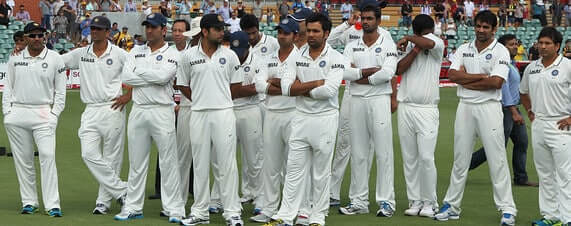SANAM SHARMA is unimpressed by the Indian cricket team’s performance in their first Test match of the Australian tour

The Indian cricket team has now played two days of their first test match of the 2014 Australian tour. Well, a day and a half, with all those rain interruptions. The writing on the wall for India is written large and bold – it is going to be a long and painful summer if you are an Indian cricket supporter.
The “rockstars” of the modern cricketing world arrived in Australia in all their glory. Demanded the game be played on their terms – “No DRS, please”. The BCCI sets up mega financial deals to rake in insane amounts of revenue. The media touted it as the “marquee” cricket series of the year. Anticipation went sky high.
Then, on 9 December, the two teams stepped out on to the playing arena for their first face-off. And in a very short while, it became abundantly evident that this Indian outfit will struggle to avenge the pain inflicted on the last Indian team (and the supporters) that visited Australia a couple of years ago.
While the Aussies, high on emotion, and still grieving the loss of Phil Hughes, stood up to the big occasion and collectively made sure they made their “little buddy” proud in the heavens. The Indians, it seemed, merely turned up for just another game of cricket. No real plan or intensity behind their proceedings, especially by the Indian bowling unit. The fielding was patchy, as it so often is.
Bowling, and taking wickets, in test matches is precious little art. The skill lies in the ability of a bowler to construct the dismissal of a batsman by chipping away at a teasing line and length on or around the off-stump. Continuously. Every single ball, every single over.
Hit the same spots as often as you can. Test the batsman’s focus and resolve with the occasional bumper, and then go back to that nagging off stump line. Keep sucking in the batsmen and eventually they will crumble. It’s like weaving the perfect trap. And that requires patience, consistency, and a lot of heart. Much like the fabled “Chakravyuha” from the ancient Hindu mythology. And once you get a batsman out, you repeat the above routine until you get 19 more scalps, within a space of five days.
The Indian bowlers, over the first two days of the Adelaide test, have struggled to hold it together. They have been wayward, inconsistent, and simply ineffective. That the drop-in pitch does not offer much assistance is no excuse for the inability of the Indian bowlers to pitch the ball in good areas for at least 4 or 5 balls in an over. Consistently.
Shami has the skill to swing the new ball and reverse it with the old one. The deliveries that he manages to put in the right areas do have a class about them. And he does so at a decent pace, too. However, more often than not, he follows up a good delivery with an outrageous one. And in a test match setting, that is the relief valve a good batsman always seeks. To get to the other end. Or punch through a boundary to deflect the pressure back on the bowler.
Aaron has a lot of pace, but no real discipline or control. He pretty much runs in and delivers whatever he can at around 140km/h, and then hopes for a miracle. Every single delivery.
Ishant Sharma was perhaps the most economical bowler in these two opening days. But, for the leader of the bowling pack, he only had a solitary wicket to show for in his numbers.
The Indian bowling squad lacked an obvious plan and penetration on the first two days of this tour. The Indian bowlers, frankly, did not ask too many questions of the Australian batsmen. Michael Clarke, with his evident discomfort due to the back injury, was afforded a century without being overly troubled. That pretty much sums up the ineffectiveness of the Indian bowling.
So, like any other time, it will be up to the Indian batsmen to try and dig in and bat for a draw. A batting line-up that is young and relatively untested. A batting line-up featuring some power hitters in the short format, but with no proven credentials for the longer form of the game. And that is a tall ask.
Test matches, more often than not, are won by teams who have the bowling prowess to take 20 wickets within five days. A strong batting outfit can at best rescue matches, but will not win them for you every time.
Until this Indian bowling unit brings in a lot more discipline and accuracy to their execution, this Aussie summer of cricket is going to be a harsh one for the Indian fans. Yet again.





